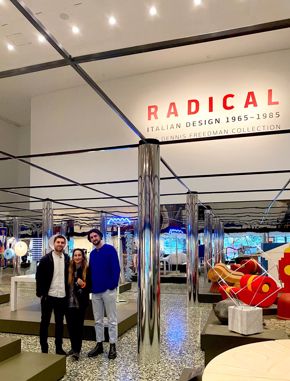Designing an Exhibition about Radical Design July 1, 2020

The Almost Studio design team (left to right): Anthony Gagliardi, Jessica Flore Angel, and Dorian Booth.
The Almost Studio design team (left to right): Jessica Flore Angel, Dorian Booth, and Anthony Gagliardi.
Installation view of Radical: Italian Design 1965–1985, The Dennis Freedman Collection.
Installation view of Radical: Italian Design 1965–1985, The Dennis Freedman Collection.
Installation view of Radical: Italian Design 1965–1985, The Dennis Freedman Collection.
Installation view of Radical: Italian Design 1965–1985, The Dennis Freedman Collection.
How do you design the layout for an exhibition about Radical design? Architect Anthony Gagliardi of Almost Studio, the Brooklyn-based design firm behind the installation concept for Radical: Italian Design 1965–1985, The Dennis Freedman Collection, explains.
The objects in Radical: Italian Design are from the collection of Dennis Freedman. Where did you first meet him?
At his apartment. I went there with my Almost Studio colleagues Jessica Flore Angel and Dorian Booth. The space, similar to how the MFAH installation appears today (minus the columns and mirrors), was filled with furniture pieces we had admired only in publications.
How long did it take to design the layout for the exhibition?
We began working with Dennis at the end of 2018. As with any project, architects work on the design until the very last moment, when either someone tells you to stop, or the element you want to change is built. In reality a project is never complete, which refers back to our firm name: Almost Studio. It attempts to capture the fact that the ideas, forms, and provocations of a project affect people and transform over time—similar to how one could argue the concepts of the Radical design movement in Italy during the 1960s and 1970s are just as active today.
How long did it take to install the exhibition itself?
It depends on what you consider the start date. The physical installation took approximately two weeks. However, for several months before that, the MFAH team was building full-scale mock-up tests of portions of the exhibition.
Each object within the exhibition is so different from the next. How did planning this installation compare with your usual process?
It’s true, each piece has its own character and attitude. This is where the infinite expanse of columns and ceiling grid, derived from Archizoom’s 1969 project No-Stop City, plays a significant role. The infinite horizontal landscape, generated by the mirrored walls and columns, amplifies the performance of each furniture or lighting element. Paradoxically, the way of highlighting individuality is through the standardization and repetition of all other conditions. The design of this exhibition is specific to both the objects in the collection and the idea of the collection.
Radical: Italian Design heads to the Yale Architecture Gallery at the Yale School of Architecture in the fall of 2021. Will you have any involvement in the installation there?
Yes. We’ll let that be the teaser.
► See Radical: Italian Design 1965–1985, The Dennis Freedman Collection in the Law Building through September 7.





